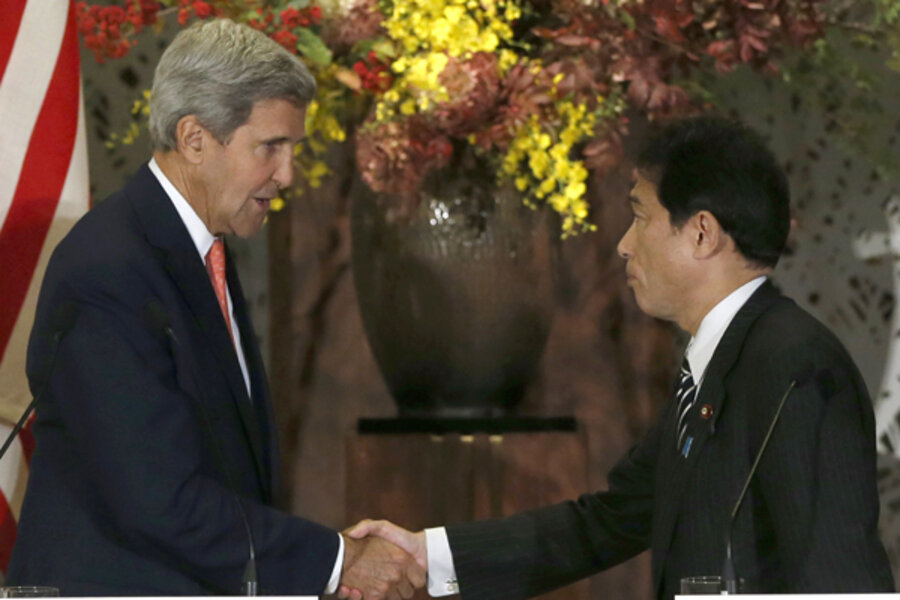Japan, US fortify military ties with drones. Will China take note?
Loading...
| Tokyo
Japan and the US have agreed to strengthen their alliance to address threats to regional security from North Korea’s missile program and China’s increasingly robust claims to disputed island territories, in the first broadening of the two powers' military alliance in nearly two decades.
The 10-page joint statement, which was finalized by the Japanese and US defense ministers in Tokyo on Thursday, included cooperation on a wide range of issues, from cyber-attacks and terrorism, to security in space and joint military exercises.
"Japan is changing and so is its neighborhood," US Secretary of State John Kerry told reporters after the “two-plus-two” meeting between the US and Japanese foreign and defense ministers. "So we're coming together now to modernize our deep cooperation, through both our military alliances and our diplomatic partnerships, and that is so we can better prevent and respond to the ever-changing threats of the 21st century."
The Asia-Pacific has become vulnerable to new threats in the 16 years since the allies last revamped their defense partnership.
North Korea has continued to develop nuclear weapons and a long-range ballistic missile program, in defiance of the international community. China, meanwhile, is causing concern with its dramatic rise in military spending and aggressive claims to maritime territories.
Relations between China and Japan have deteriorated sharply in the past year over their rival claims to the Senkaku islands – known as the Diaoyu in China – in the East China Sea.
With the Senkaku dispute in mind, Tokyo and Washington agreed to deploy long-range surveillance drones to monitor the islands by next spring, in a move that could further raise tensions with China.
The revamped guidelines do not mention the Senkakus by name, but the decision to base US Global Hawk drones at American bases in Japan for the first time is a sign of growing disquiet over frequent Chinese maritime activity near the islands.
Publicly, the US has refused to takes sides over the dispute but recognizes it must help defend Japanese territory under bilateral treaty obligations. Japan administers the islands, which are uninhabited but surrounded by potentially large deposits of natural gas. Japan bought the islands from their private owners just over a year ago, and argues that China only began voicing a claim in the 1970s, when studies suggested that oil and gas deposits might be found near the islands.
"We strongly oppose any unilateral or coercive action that seeks to undermine Japan's administrative control," said US Defense Secretary Chuck Hagel.
Japan’s foreign minister, Fumio Kishida, said the security environment in the Asia-Pacific had become “increasingly severe,” and issued a thinly veiled warning to China not to raise tensions over the Senkakus. "We are decidedly opposed to the attempt to change the status quo through coercion,” he said. “Rule of law is critically important."
The US and Japanese joint statement urged China to "play a responsible and constructive role in regional stability and prosperity, to adhere to international norms of behavior."
Officials in China, which is marking a week-long national holiday, have yet to respond to the new agreement. The country’s foreign ministry, however, has previously criticized the deployment of the first military radar system in Japan, saying it would destabilize the region.
To counter the threat from North Korea, Japan and the US agreed to position a second X-band radar system in Japan within the next year. The radar will enable Tokyo to track missiles from the North aimed at either country.
Mr. Kerry repeated Washington’s offer of a non-aggression treaty with Pyongyang, provided it abandons its nuclear weapons program and complies with UN resolutions on ballistic missile development.
At the meeting, the officials, who also included Japan’s defense minister, Itsunori Onodera, discussed the delicate issue of the US military presence on the island of Okinawa, home to the bulk of US military bases in Japan.
In a bid to reduce tensions between US troops and Okinawa residents, Japan agreed to contribute $3.1 billion toward the $8.6 billion cost of relocating about 9,000 marines from the island, including 5,000 to the US Pacific territory of Guam.
The new defense guidelines come as the Obama administration attempts to shift its attention on the Asia-Pacific region, and as Japan’s prime minister, Shinzo Abe, seeks to bolster his country’s military capabilities.
In a speech in the US last week, Mr. Abe said Japan should no longer be a “weak link” in global security, and should play a more active role in its alliance with the US.






